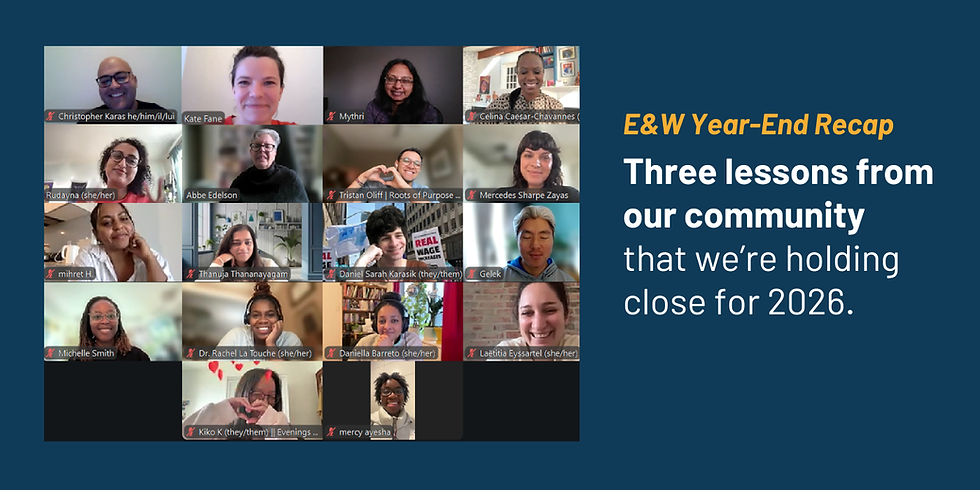Strategic planning? Start by listening.
- Laëtitia Eyssartel

- Jun 17, 2022
- 4 min read
Updated: Jul 25, 2022
“This is the world as it is. This is where you start.” ― Saul Alinsky
After more than two years of turmoil, many organizations have suddenly found themselves with time to reflect this summer.
Gone are the knee-jerk responses to the pandemic and its ensuing racial reckonings.
Instead, leaders are seizing this moment of relative calm to revisit their strategic plans, assess the relevance of their missions and values, and craft longer-term plans for the future.
These leaders are often asking important questions about how their organizations can serve their broader hopes for change, and address issues of income inequality, racial justice, climate sustainability, and decolonization―among others.
“Given the massive problems facing our society,” they’re asking, “how can we ensure we make the biggest impact?”
We’re delighted to see this new spirit of inquiry. After all, these are very different questions than we were hearing in the sector just a few years back, when the conversation was dominated by digital innovation and donor-centred fundraising.
We launched Evenings & Weekends Consulting to collaborate with these non-profits, charities, activists, local leaders, community groups and policy makers as they advance progressive change. It’s clear there’s a hunger for such collaborators: people are coming to us before they’re even sure what services they’re looking for.
Our guidance to them? Well, usually it’s to start by listening.
We don’t mean listening to their Twitter feeds, to their anxious funders, to alarmist headlines, or even to us, exclusively. We mean deep, empathetic listening to the people their organizations serve, and to the people who provide those services.
This may sound like overly simplistic advice, but listening is a skill that few people have been given the tools to do well. Most are conditioned to listen only as a means of acquiring data, or of reinforcing what they think they already know.
A strategic listener, however, listens to challenge their own assumptions, and to deepen relationships with those around them.
These goals are crucial to creating an effective strategic planning process―particularly in the nonprofit sector where power differentials are stark and partnerships are essential. A strategy is only as good as the data it’s based upon, and accurate data won’t be shared unless stakeholders feel they can trust both you and the process.
What are your staff member’s strengths and dreams? What are they worried about in their workplace? How do the members of the community you serve or collaborate with feel about the work that you’re doing? What do they feel are the opportunities for progress both in and outside of your organization?
These questions are key to strategic planning, but you won’t find the answers in an annual all-staff Q&A, or from an anonymous survey from your HR department. Rather, they require leadership to create meaningful and ongoing spaces for listening, and to demonstrate vulnerability, humility, emotional maturity, and professionalism when listening themselves.
It can be challenging work to build these skills and structures, but the payoffs are massive.
Here’s an example:
When Paul was living in Vancouver, he was involved with a coalition of community organizations who were seeking to alleviate poverty. Before they identified any particular policy goal or organizing principle, they held a series of focus groups with people experiencing poverty in the community.
What they discovered surprised them: the low-wage factory workers they spoke with weren’t citing food access or housing affordability as their top concern.
Nope, it was the bus schedule.
It turns out that there wasn’t a bus that came early enough to get them to the factory. To make it to their early morning shifts, people were forced to spend money on sharing expensive cabs, or else risk being fired for coming to work late.
After listening to these workers, and to folks in the community who depended on the income of the factory workers, the coalition arranged meetings with representatives from the Transit Authority. They supported the workers to tell their stories about their fears about being fired, how much money they were spending on cabs, and the impact that an earlier bus would have on their lives.
Two months later, the Transit Authority introduced an earlier bus. This small action had a massive impact on the economic wellbeing of the community.
By creating space for listening, and for building trust, the coalition was able to succeed in its mission of alleviating poverty.
Remember, the goal of strategic planning isn’t always to fully eradicate the social issues that make your organization necessary. Instead, it can be about building relationships, ongoing listening, and collectively working on the things that matter to those involved.
Your board may be disappointed with the scope of your plans, but trust us: with a strong understanding of your organization’s assets, and a solid foundation of community trust, you’ll be far better equipped to succeed in your missions.
As famed community organizer Saul Alinsky wrote, “This is the world as it is. This is where you start.”
We believe that Saul’s teachings can be a fantastic template for nonprofits that are committed to social change. Many of his core principles are directly applicable to running a successful strategic planning process, including “Never go outside the expertise of your people,” and “A good tactic is one your people enjoy.”
Principles that can only be put into practice by, you guessed it, listening to your people.
If you want your strategic planning process to truly build power in your organization and beyond, then listen to Saul―start by listening.
Paul & Laetitia
Evenings & Weekends Consulting
_______________________________________________________________________
Did you know? Evenings & Weekends Consulting donates 10% of its proceeds to the Anishinawbe Health Foundation.





Comments